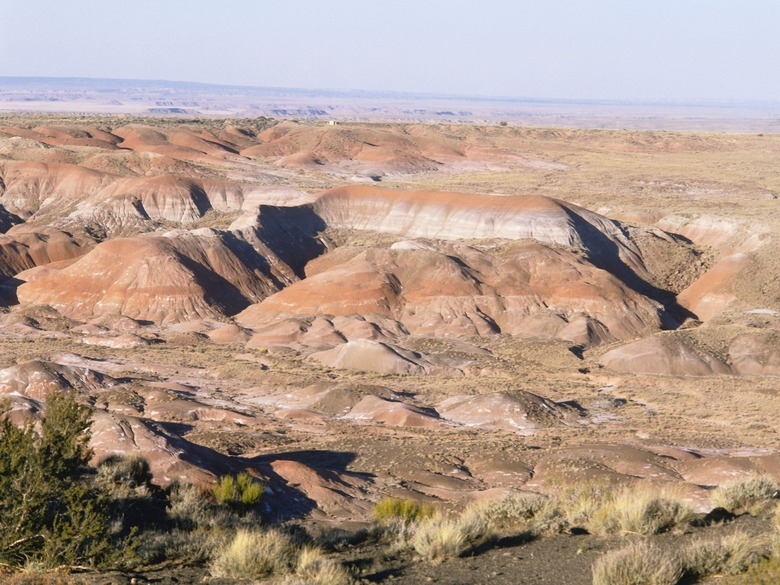What Is The Climate Of The Painted Desert?
In the Painted Desert, layers of clay and limestone in shades of red, orange, gray and lavender create a stunning tapestry that changes throughout the day as the sun travels across the landscape. Its location, nestled between the Grand Canyon and Petrified Forest National Park, makes it a prime destination for tourists visiting the American Southwest. While its name may lead you to believe that the Painted Desert is always dry and sunny, the climate in this region is actually quite diverse, with bright, sun-filled summers, chilly winters and plenty of precipitation throughout the year.
Average Temperature
Average Temperature
Temperatures within the Painted Desert vary from very hot to very cold, and temperatures can change rapidly. Over the period 1973 to 2012, the average temperature in January was 1.72 degrees Celsius (35.1 degrees Fahrenheit), according to the Western Regional Climate Center. The temperature in July averaged 24.4 degrees Celsius (76 degrees Fahrenheit) over the same period. On average, the maximum temperature exceeds 32.2 degrees Celsius (90 degrees Fahrenheit) for 57 days each year, while the minimum temperature drops below 0 degrees Celsius (32 degrees Fahrenheit) for 132 days out of the year.
Average Rainfall
Average Rainfall
From 1973 to 2012, the region received an average of 26.75 centimeters (10.53 inches) of rainfall each year, according to the Western Regional Climate Center. The lowest annual rainfall was reported in 1976, with just 19.08 centimeters (7.51 inches). In 1982, a record high of 46.86 centimeters (18.45 inches) of rain fell on the Painted Desert. The largest rainfall in a single day occurred in 1990, with a total of 4.95 centimeters (1.95 inches).
Monsoon Season
Monsoon Season
Like many low-latitude regions, the Painted Desert experiences an annual monsoon season. Throughout much of the year winds blow from the west or northwest. At the start of each summer, the desert landscape in Arizona and the southwest heats up more rapidly than the surrounding oceans and other water bodies. This heat differential between the land and the sea causes the winds in the region to shift direction, resulting in a summer monsoon season. Rather than blowing from the west, they instead blow from the south or southeast, drawing moisture-rich air from the Gulf of Mexico and Gulf of California over the Painted Desert and other parts of Arizona. The summer monsoon season is characterized by heavy rain and frequent thunderstorms, making it the rainiest season for the Painted Desert region. On average, the Painted Desert receives 3.3 centimeters (1.30 inches) of rain each July, 4.27 centimeters (1.68 inches) in August and 3.20 centimeters (1.26 inches) each September. Once the monsoon season ends in late September, the winds switch back, blowing from the west or northwest once again and reducing monthly rainfall levels. (Rainfall amounts come from Ref 2)
Snow
Snow
The U.S. Forest Service reports that 45 percent of the precipitation in the Painted Desert falls during the winter, resulting in surprisingly frequent snowfall for a desert region. More than 0.025 centimeters (0.01 inches) of snow falls in the Painted Desert on an average of 59 days each year, and at least 1.27 centimeters (0.5 inches) of snow falls on an average of five days or more each year. While the area receives an average of 26.92 centimeters (10.6 inches) of snow per year, more than 115.31 centimeters (45.4 inches) fell in 1975, making it one of the snowiest years on record for the Painted Desert.
References
- Western Regional Climate Center: Painted Desert National Park. Arizona–Period of Record General Climate Summary–Temperature
- Western Regional Climate Center: Painted Desert National Park. Arizona–Period of Record General Climate Summary–Precipitation
- U.S. Forest Service: Ecological Subregions of the United States
- National Weather Service Forecast Office: The Monsoon
Cite This Article
MLA
Beach, Emily. "What Is The Climate Of The Painted Desert?" sciencing.com, https://www.sciencing.com/climate-painted-desert-4577/. 24 April 2017.
APA
Beach, Emily. (2017, April 24). What Is The Climate Of The Painted Desert?. sciencing.com. Retrieved from https://www.sciencing.com/climate-painted-desert-4577/
Chicago
Beach, Emily. What Is The Climate Of The Painted Desert? last modified March 24, 2022. https://www.sciencing.com/climate-painted-desert-4577/
